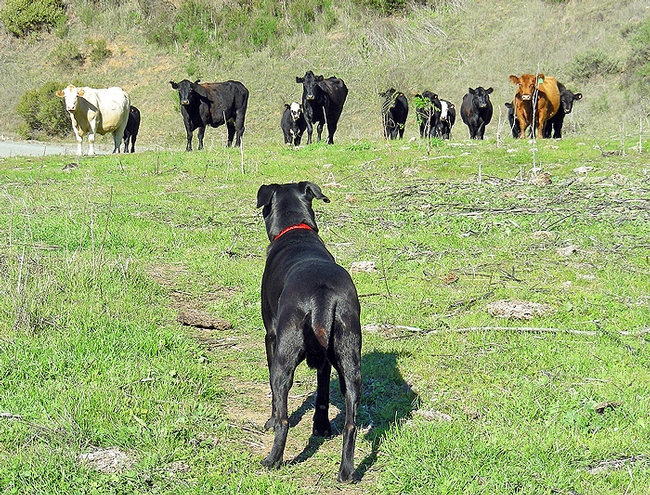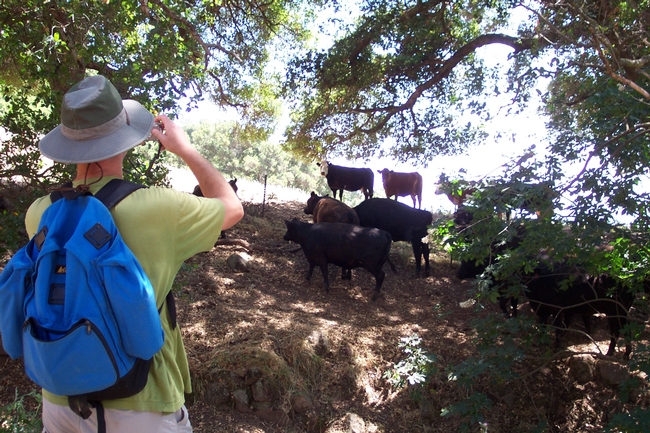
To get a more complete picture of public perceptions of cattle grazing, Sheila Barry, University of California Cooperative Extension advisor in the San Francisco Bay Area, analyzed photos and comments in the photo-sharing website Flickr.
Her study, published in the February 2014 issue of Environmental Management, showed that Flickr can provide insight both through photos and comments into public perspectives on grazing in parks and open space lands.
“These are just a first step toward broadening this understanding,” Barry wrote. “Further analysis of social media may provide managers with broader insights into public opinion compared to those afforded by traditional methods on a wide range of issues important to park and open space management.” Livestock grazing reduces the volume of plants that can fuel fire and improves wildlife habitat. But some public land managers, concerned about potential conflicts with park users, limit or ban grazing. In 2009, the city of Walnut Creek decided to end grazing in two city parks. A year later, neighbors who were concerned about weeds contributing to wildfire petitioned the city to resume cattle grazing.
Assessments of public perceptions are often based on public hearings, which tend to attract special interests and favor negative input, or on surveys, which focus on a topic.
“Despite numerous studies that have shown benefits of grazing for endangered species in California, some environmental groups and park users have filed lawsuits to curtail grazing on public rangelands,” Barry said. “I think there's an opportunity to educate people that if grazing is well managed, it won't interfere with their recreational use and there are benefits to society.”
The San Francisco Bay Area has over 133,000 acres of public land that is grazed by cattle and used by people to hike, ride bikes, walk dogs, ride horses and hang glide.
Barry set out to explore how people voluntarily described their feelings about cattle grazing in the San Francisco Bay Area on social media. She examined photos and comments on Flickr. Using the search terms “cow,” “cows” and “grazing,” she found 1,087 photos of grazed regional parks in Alameda, Contra Costa or Santa Clara counties by 328 people with 956 comments.
Of the 733 photos that were accompanied by comments, 71 percent showed a cow and 71 percent of the comments were descriptive without expressing opinion about cows or grazing. Comments included “Lots of wildflowers and cows. Hello tiny cows on the hillside.” “Taken at Lake Del Valle.” “I don't know why, but I thought cows in California were kept indoors.” About 23 percent were positive toward cows and grazing, such as “Wonderful to see cows being just cows and happy ones” and “As much as I struggled over the steep hills on this hike, all the grazing cattle and howling coyotes made it worth the sweat.”

Fear of cows was expressed by 5 percent of commenters and included comments such as “I try to conquer my fear of cows by photographing them,” “The cows scared us to death. I told them that I'm a vegetarian and they let me go” and “We turned around when we were faced with the option of having to walk right through a herd of cows.”
Less than 1 percent described cows behaving aggressively, such as “At least these cows didn't chase us like last week's did.”
Although more research is needed to learn how to collect, analyze and interpret data from social media, Barry believes it could be a valuable source for informing decisions about public policy.
Insight into public perceptions of cattle grazing will enable park managers to craft more effective education and interpretation messages about park use and management.
“We are currently using insight from this project to develop education and interpretative information and panels for parks in the East Bay,” Barry said.
Barry is publishing fact sheets for park managers and interpreters to share with park visitors. The fact sheets will address concerns she saw raised in the Flickr study such as how to safely and comfortably recreate in a park near grazing cattle and the benefits of cattle grazing in parks. She will also address public interest and questions revealed in the Flickr study with facts sheets titled “A Year in the Life” and “Bovines, Ovines, Caprines and Equines: What's the difference?” The fact sheets will also be available online and similar information will be posted in parks on interpretative panels.
The article “Using Social Media to Discover Public Values, Interests, and Perceptions about Cattle Grazing on Park Lands” can be downloaded at http://link.springer.com/article/10.1007%2Fs00267-013-0216-4.